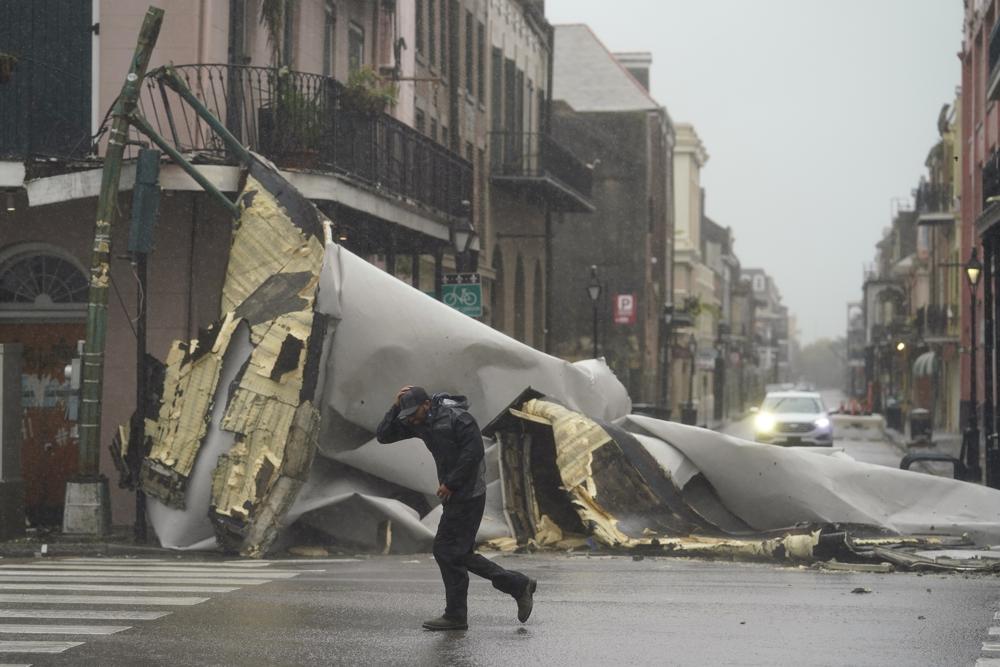NEW ORLEANS (AP): Hurricane Ida blasted ashore Sunday as one of the most powerful storms ever to hit the U.S., knocking out power to all of New Orleans, blowing roofs off buildings and reversing the flow of the Mississippi River as it rushed from the Louisiana coast into one of the nation’s most important industrial corridors.
The Category 4 storm hit on the same date Hurricane Katrina ravaged Louisiana and Mississippi 16 years earlier, coming ashore about 45 miles (72 kilometers) west of where Category 3 Katrina first struck land. Ida’s 150-mph (230 kph) winds tied it for the fifth-strongest hurricane to ever hit the mainland U.S. It dropped hours later to a Category 3 storm with maximum winds of 115 mph (193 kph) as it crawled inland, its eye 30 miles (48 kilometers) west of New Orleans.
The rising ocean swamped the barrier island of Grand Isle as landfall came just to the west at Port Fourchon. Ida made a second landfall about two hours later near Galliano. The hurricane was churning through the far southern Louisiana wetlands, with the more than 2 million people living in and around New Orleans and Baton Rouge under threat.
“This is going to be much stronger than we usually see and, quite frankly, if you had to draw up the worst possible path for a hurricane in Louisiana, it would be something very, very close to what we’re seeing,” Gov. John Bel Edwards told The Associated Press.
People in Louisiana woke up to a monster storm after Ida’s top winds grew by 45 mph (72 kph) in five hours as the hurricane moved through some of the warmest ocean water in the world in the northern Gulf of Mexico.
The entire city of New Orleans late Sunday was without power, according to city officials. The city’s Office of Homeland Security & Emergency Preparedness said on Twitter that energy company Entergy confirmed that the only power in the city was coming from generators. The message included a screenshot that cited “catastrophic transmission damage” for the power failure.
The wind tore at awnings, water spilled out of Lake Ponchartrain in New Orleans, and boats broke loose from their moorings. The Coast Guard office in New Orleans received more than a dozen reports of breakaway barges, said Petty Officer Gabriel Wisdom. In Lafitte about 35 miles (56 km) south of New Orleans, a loose barge struck a bridge, according to Jefferson Parish officials.
Elsewhere, engineers detected a “negative flow” on the Mississippi River as a result of storm surge, U.S. Army Corps of Engineers spokesman Ricky Boyette said.
Edwards said he watched a live video feed from around Port Fourchon as Ida came ashore.
“The storm surge is just tremendous. We can see the roofs have been blown off of the port buildings in many places,” Edwards told the AP.
Officials said Ida’s swift intensification from a few thunderstorms to a massive hurricane in just three days left no time to organize a mandatory evacuation of New Orleans’ 390,000 residents. Mayor LaToya Cantrell urged residents remaining in the city on Sunday to “hunker down.”
Marco Apostolico said he felt confident riding out the storm at his home in New Orleans’ Lower 9th Ward, one of the city’s hardest-hit neighborhoods when levees failed and released a torrent of floodwater during Katrina.
His home was among those rebuilt with the help of actor Brad Pitt to withstand hurricane-force winds. But the memory of Katrina still hung over the latest storm.
“It’s obviously a lot of heavy feelings,” he said. “And yeah, potentially scary and dangerous.”
The region getting Ida’s worst includes petrochemical sites and major ports, which could sustain significant damage. It is also an area that is already reeling from a resurgence of COVID-19 infections due to low vaccination rates and the highly contagious delta variant.
New Orleans hospitals planned to ride out the storm with their beds nearly full, as similarly stressed hospitals elsewhere had little room for evacuated patients. And shelters for those fleeing their homes carried an added risk of becoming flashpoints for new infections.
Forecasters warned winds stronger than 115 mph (185 kph) threatened Houma, a city of 33,000 that supports oil platforms in the Gulf.
The hurricane was also threatening neighboring Mississippi, where Katrina demolished oceanfront homes. With Ida approaching, Claudette Jones evacuated her home east of Gulfport, Mississippi, as waves started pounding the shore.
“I’m praying I can go back to a normal home as I left,” she said. “That’s what I’m praying for. But I’m not sure at this point.”
